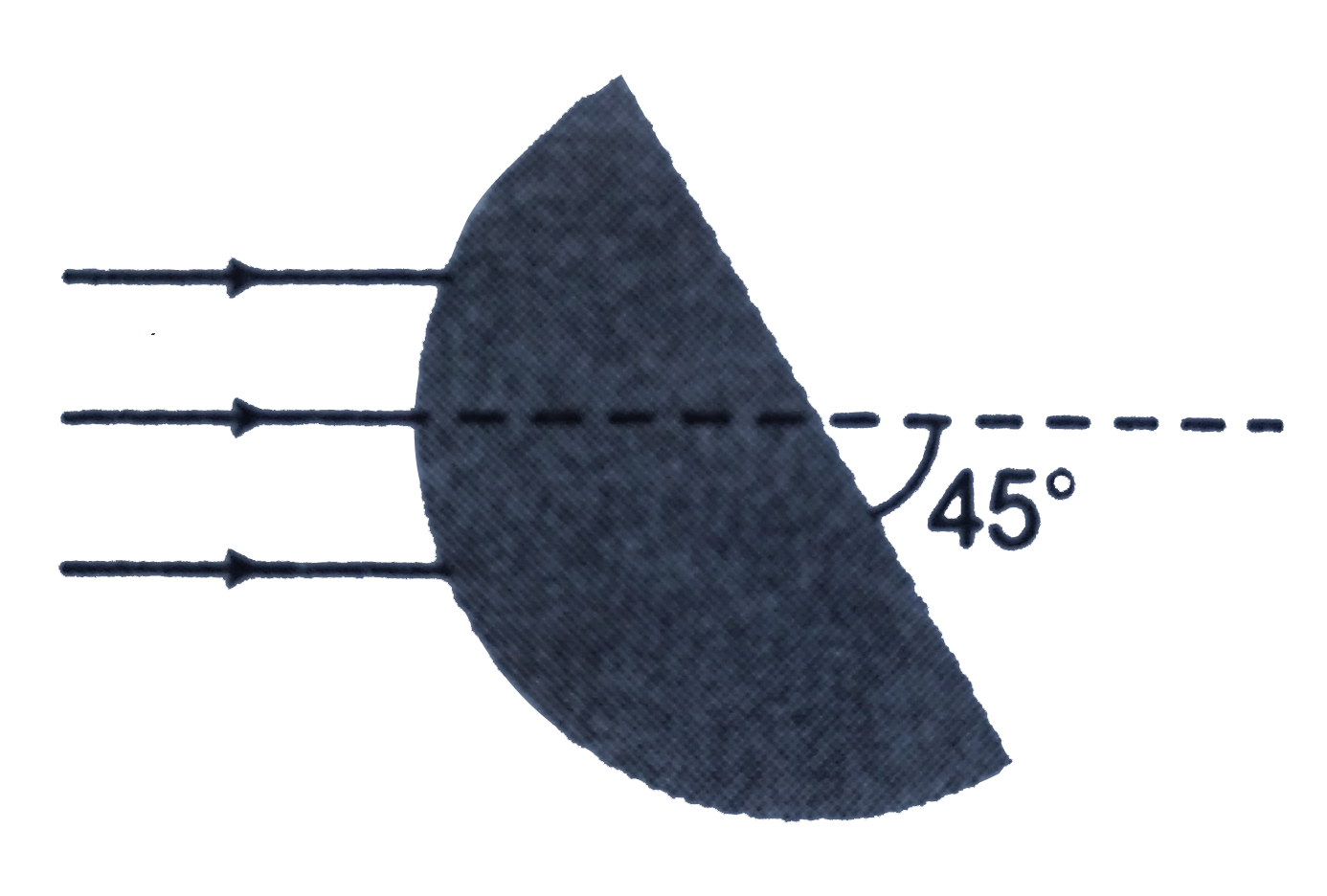A parallel bean of light travelling in water (refractive index = 4/3) is refracted by a spherical bubble of radius 2 mm situation in water. Assuming the light rays to be paraxial. i. find the position of the image due to refraction at the first surface and the position of the final image, and ii. draw a ray diagram showing the positions of the images. Solution in Tamil
 <br> The ray diagram is shown in ure. The equation for refractioin at a spherical surface is <br> <span class=) μ22−μ12=μ2−μ1R………….i
μ22−μ12=μ2−μ1R………….i
For the first refraction (water to air ) μ1=1.33,μ2=1,u=∞,R=+2 mm.
Thus, 1v=1−1.332mm
or v=-6mm<br>The¬ativesignshowstˆtheima≥I_1isvirtualandformsat6mmomthesurfaceofthebu≤onthewaters.Theretedrays(whichseem→comeomI_1)are∈cntonthefarthersurfaceofthebu≤.forthisretion.<br>mu_1=1, mu_2=1.33, R=-2mm<br>theobjectdistanceisu=-(6mm=4mm)=-10mm. Usingequationi<br>1.33/v+1/(10mm)=(1.33-1)/(-2mm)<br>or1.33/v=-0.33/(2mm)-1/(10mm)<br>v=−5mm
the minus sigh shows that the image is formed on the air side at 5 mm from the refracting surface.
Measuring from the centre of the bubble,the first image is formed at 8.0 mm from the centre and the second image is formed at 3.0 mm from the centre. Both images are formed on the side from which the incident rays are coming.
Topper's Solved these Questions
- BOOK - HC VERMACHAPTER - GEOMETRICAL OPTICSEXERCISE - Question For short Answer19videos
GEOMETRICAL OPTICS
- BOOK - HC VERMACHAPTER - GEOMETRICAL OPTICSEXERCISE - Objective -118videos
GEOMETRICAL OPTICS
- BOOK - HC VERMACHAPTER - GEOMETRICAL OPTICSEXERCISE - Exercises79videos
GEOMETRICAL OPTICS
- BOOK - HC VERMACHAPTER - GAUSS LAWEXERCISE - Exercises24videos
GAUSS LAW
- BOOK - HC VERMACHAPTER - LIGHT WAVESEXERCISE - Exercises41videos
LIGHT WAVES
Similar Questions
Is the formula "Real depth/Apparent depth =μ. valid if viewed from a position quite away from the normal ?
01:46View SolutionA point source of light is placed in front of a plane mirror.
03:49View SolutionA concave mirror having a radius of curvature 40 cm is placed in front of an illuminated point source at a distance of 30 cm from it. Find the location of the image.
03:03View SolutionThe electric field in a region is given by →E=35E0→i+45E0→j with E0=2.0×103NC−1. Find the flux of this field through a recatngular surface of area 0.2m2 parallel to the y-z plane.
01:45View SolutionFind the range of frequency of light that is visible to an average human being (400nm<λ<700nm)
02:12View SolutionA parallel narrow beam of light is incident on the surface of a transparent hemisphere of radius R and refractive index μ=1.5 as shown. The position of the image formed by refraction at the image formed by refraction at the spherical surface only as
 08:02View Solution
08:02View SolutionA parallel beam of light travelling in water (refractive index =4//3) is refracted by a spherical air bublle of radius 2mm situated in water. Assuming the light rays to be paraxial, a. Find the position of image due to refraction at first surface and position of the final image. b. Draw a ray diagram showing the position of both images.
View SolutionAn object of height 1mm is placed inside a sphere of refractive index mu=2 and radius of curvature 20 cm as shown in the figure. Find the position, size, and nature of image, for the situation shown in Figure. Draw ray diagram.
02:10View SolutionA parallel beam of light is incident on the surface of a transparent hemisphere of radius R and refractive index 2.0 as shown in figure. The position of the image formed by refraction at the first surface is :
05:50View SolutionWhat is meant by the 'angle of incidence' and the 'angle of refraction' for a ray of light? Draw a labelled ray diagram to show the angle of incidence and the angle of refraction for a refracted ray of light.
07:08View Solutionजल में चल रहा प्रकाश का एक समान्तर किरण-पुँज, जल में स्थित 4 मिमी व्यास के गोलीय वायु के बुलबुले से अपवर्तित होता है | प्रकाश- किरणों को उपाक्षीय मानकर अन्तिम प्रतिबिम्ब की स्थिति ज्ञात कीजिए | ( जल का अपवर्तनांक = 4/3 ).
02:53View SolutionDescribe biprism experiment to find the wavelength of monochromatic light. Draw the necessary ray diagram for magnified and diminished images of virtual sources. If the difference in velocities of light in glass and water is 2.7×107m/s, find the velocity of light in air.
(Refractive index of glass = 1.5Refractive index of water = 1.333)View Solutionजल तथा काँच के अपवर्तनांक क्रमश: 4/3 तथा 3/2 है। जल का अपवर्तनांक ज्ञात कीजिये यदि प्रकाश की किरण काँच से जल में गमन करती है।
01:48View SolutionAn equibiconvex lens of radius of curvature 0.20 and refractive index 1.5 immersed half inside water of RI 4//3 and the rest outside in air. A parallel beam of light in air is incident on it. Find the final position of the image.
02:43View Solutionजल ( अपवर्तनांक = 4/3 ) में चल रहा प्रकाश का एक समान्तर किरण पुँज, जल में स्थित 2 मिमी त्रिज्या के गोलीय वायु के बुलबुले से अपवर्तित होता है | प्रकाश किरणों को उपाकशीय मानकर ( a ) प्रथम पृष्ठ से अपवर्तन के कारण बनने वाले प्रतिबिम्ब की स्थिति तथा अंतिम प्रतिबिम्ब की स्थिति ज्ञात कीजिए |( b ) दोनों प्रतिबिम्बों की स्थितियाँ बताने वाला किरण - आरेख खींचिए |
03:00View Solution(a) Light enters from air to glass having refractive index of 1.50. What is the speed of light in glass? The speed of light in vacuum is 3xx10^(8)ms^(-1) . (b) An object is situated at a position in between the main focus (F) and 2F of a convex lens. Draw the ray diagram showing the position, size and nature of image formed.
04:58View Solution

